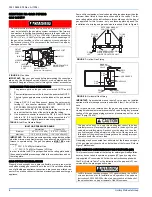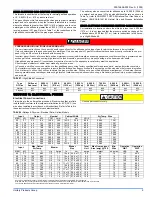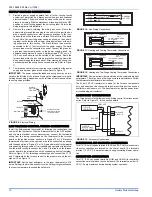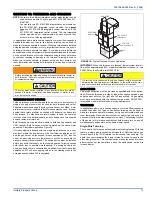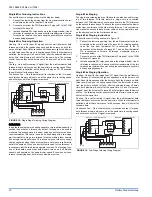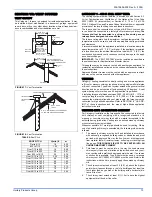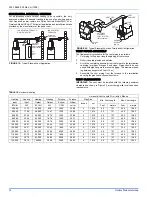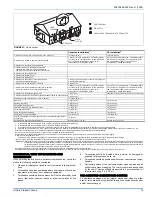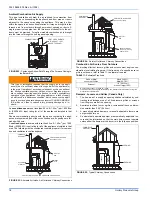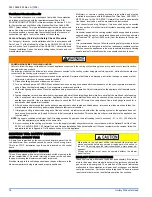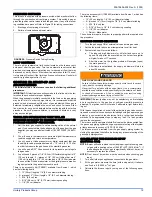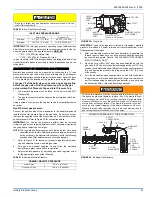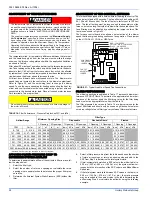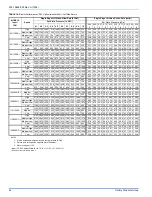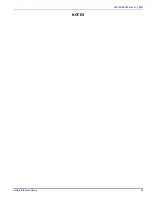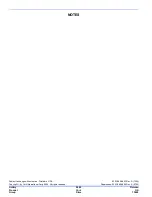
035-19656-003 Rev. A (1004)
22
Unitary Products Group
ADJUSTMENT OF TEMPERATURE RISE
The temperature rise, or temperature difference between the return air
and the heated supply air from the furnace, must be within the range
shown on the furnace rating plate and within the application limitations
as shown in Table 8.
After about 20 minutes of operation, determine the furnace temperature
rise. Take readings of both the return air and the heated air in the ducts,
about six feet (1.83 m) from the furnace where they will not be affected
by radiant heat. Increase the blower speed to decrease the temperature
rise; decrease the blower speed to increase the rise.
All direct-drive blowers have multi-speed motors. The blower motor
speed taps are located in the control box in the blower compartment.
Refer to Figure 33, and the unit-wiring label to change the blower
speed. To use the same speed tap for heating and cooling, the heat ter-
minal and cool terminal must be connected using a jumper wire and
connected to the desired motor lead. Place all unused motor leads on
Park terminals. Two are provided.
ADJUSTMENT OF FAN CONTROL SETTINGS
This furnace is equipped with a time-on/time-off heating fan control. The
fan on delay is fixed at 30 seconds. The fan off delay has 4 settings (60,
90, 120 and 180 seconds). The fan off delay is factory set to 120 sec-
onds. The fan-off setting must be long enough to adequately cool the
furnace, but not so long that cold air is blown into the heated space. The
fan-off timing may be adjusted by positioning the jumper on two of the
four pins as shown in Figure 33.
The furnace control board also allows user selection of the blower
speed that is energized during continuous fan operation. Place jumper
on the HI COOL, LO COOL, or HEAT pins.
FILTER PERFORMANCE
The airflow capacity data published in Table 17 represents blower per-
formance WITHOUT filters. To determine the approximate blower per-
formance of the system, apply the filter drop value for the filter being
used or select an appropriate value from the Table 16.
The filter pressure drop values in Table 16 are typical values for the
type of filter listed and should only be used as a guideline. Actual pres-
sure drop ratings for each filter type vary between filter manufacturers.
* Washable Fibers are the type supplied with furnace (if supplied).
APPLYING FILTER PRESSURE DROP TO
DETERMINE SYSTEM AIRFLOW
To determine the approximate airflow of the unit with a filter in place, fol-
low the steps below:
1.
Select the filter type.
2.
Select the number of return air openings or calculate the return
opening size in square inches to determine the proper filter pres-
sure drop.
3.
Determine the External System Static Pressure (ESP) without the
filter.
4.
Select a filter pressure drop from the table based upon the number
of return air openings or return air opening size and add to the
ESP from Step 3 to determine the total system static.
5.
If total system static matches a ESP value in the airflow table (i.e.
0.20 w.c. (50 Pa), 0.60 w.c. (150 Pa), etc,) the system airflow cor-
responds to the intersection of the ESP column and Model/Blower
Speed row.
6.
If the total system static falls between ESP values in the table (i.e.
0.58 w.c. (144 Pa), 0.75 w.c. (187 Pa), etc.), the static pressure
may be rounded to the nearest value in the table determining the
airflow using Step 5 or calculate the airflow by using the following
example.
The temperature rise, or temperature difference between the return
air and the supply (heated) air from the furnace, must be within the
range shown on the furnace rating plate and within the application
limitations shown in Table 8 “ELECTRICAL AND PERFORMANCE
DATA”.
The supply air temperature cannot exceed the “Maximum Supply
Air Temperature” specified in these instructions and on the fur-
nace rating plate. Under NO circumstances can the furnace be
allowed to operate above the Maximum Supply Air Temperature.
Operating the furnace above the Maximum Supply Air Temperature
will cause premature heat exchanger failure, high levels of Carbon
Monoxide, a fire hazard, personal injury, property damage, and/or
death.
Do not energize more than one motor speed at a time or damage to
the motor will result.
FIGURE 31:
Typical Heat/Cool Speed Tap Connections
RED - LOW SPEED
YELLOW - MED. LOW SPEED
BLACK - HIGH SPEED
BLUE -MED. HIGH SPEED
NEUTRALS
HI
COOL
HEA
T
EAC
L1
XFMR
HUM
P
ARK
P
ARK
LO
COOL
Y1 Y/Y2 W
R
G
C
FAN OFF
ADJUSTMENT
JUMPER
CONTINUOUS
FAN SPEED
JUMPER
TABLE 16:
Filter Performance - Pressure Drop Inches W.C. and (kPa)
Airflow Range
Minimum Opening Size
Filter Type
Disposable Washable
Fibers* Pleated
1 Opening
2 Openings
1 Opening
2 Openings
1 Opening
2 Openings
1 Opening
2 Openings
CFM
Cm/m
In³
m³
In³
m³
inwc
kPa
inwc
kPa
inwc
kPa
inwc
kPa
inwc
kPa
inwc
kPa
0 - 750
0 - 21.24
230 0.0038
0.01 0.0025
0.01 0.0025
0.15 0.0374
751 - 1000
21.27 - 28.32
330 0.0054
0.05 0.0125
0.05 0.0125
0.2
0.0498
1001 - 1250
28.35 - 35.40
330 0.0054
0.1
0.0249
0.1
0.0249
0.2
0.0498
1251 - 1500
35.42 - 42.47
330 0.0054
0.1
0.0249
0.1
0.0249
0.25 0.0623
1501 - 1750
42.50 - 49.55
380 0.0062 658 0.0108 0.15 0.0374 0.09 0.0224 0.14 0.0349 0.08 0.0199
0.3
0.0747 0.17 0.0423
1751 - 2000
49.58 - 56.63
380 0.0062 658 0.0108 0.19 0.0473 0.11 0.0274 0.18 0.0448
0.1
0.0249
0.3
0.0747 0.17 0.0423
2001 & Above 56.66 & Above 463 0.0076 658 0.0108 0.19 0.0473 0.11 0.0274 0.18 0.0448
0.1
0.0249
0.3
0.0747 0.17 0.0423

